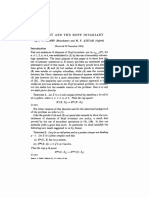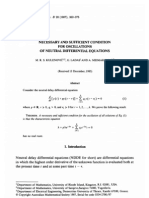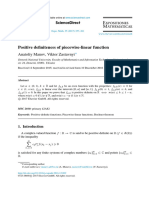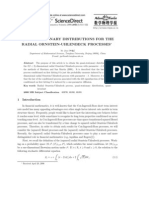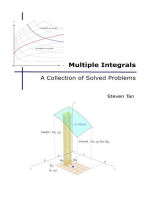Paper 2
Uploaded by
JULIA ISABEL SILVA SILVAPaper 2
Uploaded by
JULIA ISABEL SILVA SILVANewman's Short Proof of the Prime Number Theorem
Author(s): D. Zagier
Source: The American Mathematical Monthly , Oct., 1997, Vol. 104, No. 8 (Oct., 1997),
pp. 705-708
Published by: Taylor & Francis, Ltd. on behalf of the Mathematical Association of
America
Stable URL: https://www.jstor.org/stable/2975232
REFERENCES
Linked references are available on JSTOR for this article:
https://www.jstor.org/stable/2975232?seq=1&cid=pdf-
reference#references_tab_contents
You may need to log in to JSTOR to access the linked references.
JSTOR is a not-for-profit service that helps scholars, researchers, and students discover, use, and build upon a wide
range of content in a trusted digital archive. We use information technology and tools to increase productivity and
facilitate new forms of scholarship. For more information about JSTOR, please contact support@jstor.org.
Your use of the JSTOR archive indicates your acceptance of the Terms & Conditions of Use, available at
https://about.jstor.org/terms
Taylor & Francis, Ltd. and Mathematical Association of America are collaborating with JSTOR
to digitize, preserve and extend access to The American Mathematical Monthly
This content downloaded from
148.213.177.169 on Thu, 11 Feb 2021 00:21:08 UTC
All use subject to https://about.jstor.org/terms
PriRemcealNumbe
that threThenotaotreiomn .f(7r(x) g(x)x)as("fx aoo.nd g are asymptotical y equal")
Newman's Short Proof of the Prime
Number Theorem
D. Zagier
Dedicated to the Prime Number Theorem on the occasion of its 100th birthday
The prime number theorem, that the number of primes < x is asymptotic to
x/log x, was proved (independently) by Hadamard and de la Vallee Poussin in
1896. Their proof had two elements: showing that Riemann's zeta function ;(s)
has no zeros with Sc(s) = 1, and deducing the prime number theorem from this.
An ingenious short proof of the first assertion was found soon afterwards by the
same authors and by Mertens and is reproduced here, but the deduction of the
prime number theorem continued to involve difficult analysis. A proof that was
elementaty in a technical sense-it avoided the use of complex analysis-was
found in 1949 by Selberg and Erdos, but this proof is very intricate and much less
clearly motivated than the analytic one. A few years ago, however, D. J. Newman
found a very simple version of the Tauberian argument needed for an analytic
proof of the prime number theorem. We describe the resulting proof, which has a
beautifully simple structure and uses hardly anything beyond Cauchy's theorem.
means that lim<,Ot(x)/g(x) = 1, and that O(t) denotes a quantity bounded in
absolute value by a fixed multiple of f. We denote by 7T(X) the number of primes
< x.
log x
We present the argument in a series of steps. Specifically, we prove a sequence
of properties of the three functions
;(s) = E sS 4)(S) = E s , #(x) = , logp (s E ¢, x E );
n=l n p P pvx
we always use p to denote a prime. The series defining ;(s) (the Riemann zeta-
function) and 4>(s) are easily seen to be absolutely and locally uniformly conver-
gent for S(s) > 1, so they define holomorphic functions in that domain.
(I). ;(s) = Hlp(l _ p-S)-1 for S(s) > 1.
Proof: From unique factorization and the absolute convergence of ;(s) we have
;(s) 5£ (2 23r3 * ww ) = [l ( r F ) = I1 1 _ -5 ( (s) > 1) .
r2, r3, * - 20 P r20 P p
(II). ;(s)- 1 extends holomotphically to M(s) > 0.
1997] NEWMAN'S SHORT PROOF OF THE PRIME NUMBER THEOREM 705
This content downloaded from
148.213.177.169 on Thu, 11 Feb 2021 00:21:08 UTC
All use subject to https://about.jstor.org/terms
J nS - xS J dx = sJ s uS+z dx < n<um<anX+l | uS+I | = n(5)+
Proof: For M(s) > 1 we have
1 E 1 JC° 1 E Jn+lf 1 1 )
The series on the right converges absolutely for M(s) > O because
n+l t 1 1 i n+l x du I s I Isl
by the mean value theorem.
(III). #(x)= O(x).
Proof: For n E N we have
( ° ) ( 2n ) 2 ( n ) 2 I1 p = e(2n)- o(n)
and hence, since #(x) changes by O(log x) if x changes by 0(1), #(x)-#(x/2)
< Cx for any C > log 2 and all x 2 xO = xO(C). Summing this over
x, x/2, . . ., x/2r, where x/2r 2 xO > x/2r+1, we obtain #(x) < 2Cx + 0(1).
(n). ;(S) + o and 42(s) - 1/(s - 1) is holomorphic for M(s) 2 1.
Proof: For R(s) > 1, the convergent product in (I) implies that ;(s) 7s 0 and that
_ ; ( ) = E g P = q>(s) + E g P g
The final sum converges for M(s) > 2v S° this and (II) imply that <>(s) extends
meromorphically to R(s) > -, with poles only at s = 1 and at the zeros of ;(s),
and that, if ;(s) has a zero of order ju at s = 1 + ior (or E 1R, or 7s O) and a zero of
order v at 1 + 2ior(so ,u, v 2 0 by (II)), then
lim e<)(1 + e) = 1, lim e<)(1 + e _ ior ) = -u, and lim e<)(1 + e + 2ior ) = - v.
The inequality
2 (2 + r)4)(1 + e + ira) = , gP (pia/2 +p-io.X2)4 0
then implies that 6-8 ju - 2v 2 O, so ju = O, i.e., ;(1 + ior) 7s O.
(V) | ( )2 dx is a convergent integral.
Proof: For R(s) > 1 we have
log p w d(x) w (x) w
P Ps 11 Xs sl1 X5+1 dx = sl e-st t? (et) dt.
Therefore (V) is obtained by applying the following theorem to the two functions
f(t) = (et)e-t-1 and g(z) = b(z + 1)/(z + 1)-1/z, which satisfy its hy-
potheses by (III) and (IV).
NEWMAN'S SHORT PROOF OF THE PRIME NUMBER THEOREM [October
706
This content downloaded from
148.213.177.169 on Thu, 11 Feb 2021 00:21:08 UTC
All use subject to https://about.jstor.org/terms
(VI). #(x) x.
Analytic Theorem. Let f(t) (t 2 O) be a bounded and locally integrableff>nction and
suppose that the function g(z) = t t(t)e-Zt dt (R(z) > O) extends holomorphically
to M(z) 2 O. Then J f (t) dt exists (and equals g(O)).
Proof: Assume that for some A > 1 there are arbitrarily large x with #(x) 2 Ax.
Since # is non-decreasing, we have
AX (t) - t AX)X - t A A - t
1 t2 dt 2 | t2 dt = J1 t2 dt > O
for such x, contradicting (V). Similarly, the inequality #(x) < Ax with A < 1
would imply
x#(t)-t xAx-t 1A-t
IAX t dt < | 2 dt
again a contradiction for A fixed and x big enough.
The prime number theorem follows easily from (VI), since for any e > 0
# ( x) = , log p < E log x = qr ( x) log x,
p<x p<x
#(x) 2 E logp 2 , (1 - e)logx
x 1 e < p <XX x <p <x
= (1 - e) log x[X7 (x) + o(xl e )] .
Proof of the Analytic Theorem. For T > O set gT(z) = JTt(t)e-t dt. This is
clearly holomorphic for all z. We must show that limToOgT(0) = g(O).
Let R be large and let C be the boundary of the region {z E ¢l Izl < R,
B(z) 2-b}, where 6 > 0 is small enough (depending on R) so that g(z) is
holomorphic in and on C. Then
g(°) gT(0) 2gri Jc(g(Z) gT(z))e (1 + R2 ) z
by Cauchy's theorem. On the semicircle C+= C n {R(z) > o} the integrand is
bounded by 2B/R2, where B = maxt 2ol t(t)l, because
JTZ JT S ( Z )
and
e ( 1 + R 2 )- = e ( ) * R 2
Hence the contribution to g(0)-gT(0) from the integral over C+ is bounded in
absolute value by B/R. For the integral over C_= C rA {S(z) < 0} we look at
g(z) and gT(Z) separately. Since gT is entire, the path of integration for the
integral involving gT can be replaced by the semicircle C' = {z E ¢l lZl = R,
X(z) < O}, and the integral over C' is then bounded in absolute value by 2FrB/R
1997] NEWMAN S SHORT PROOF OF THE PRIME NUMBER THEOREM 707
This content downloaded from
148.213.177.169 on Thu, 11 Feb 2021 00:21:08 UTC
All use subject to https://about.jstor.org/terms
Finally, the remaining integral over C_ tends to 0 as T oo because the integrand
by exactly the same estimate as before since
Ig (z) | = |Tf(t)e-zt dt < BJT | e-ztl dt = ( St(z) < O)
is the product of the function g(z)(1 + z2/R2)/z, which is independent of T, and
the function eZT, which goes to 0 rapidly and uniformly on compact sets as T > oo
in the half-plane M(z) < 0. Hence limsuplg(O)-gT(0)l < 2B/R. Since R is
arbitrary this proves the theorem. Tx
Historical remarks. The "Riemann" zeta function ;(s) was first introduced and
studied by Euler, and the product representation given in (I) is his. The connection
with the prime number theorem was found by Riemann, who made a deep study of
the analytic properties of ;(s). However, for our purposes the nearly trivial
analytic continuation property (II) is sufficient. The extremely ingenious proof in
(III) is in essence due to Chebyshev, who used more refined versions of such
arguments to prove that the ratio of #(x) to x (and hence also of 1T(X) to x/log x)
lies between 0.92 and 1.11 for x sufficiently large. This remained the best result
until the prime number theorem was proved in 1896 by de la Vallee Poussin and
Hadamard. Their proofs were long and intricate. (A simplified modern presenta-
tion is given on pages 41-47 of Titchmarsh's book on the Riemann zeta function
[T].) The very simple proof reproduced in (IV) of the non-vanishing of ;(s) on the
line M(s) = 1 was given in essence by Hadamard (the proof of this fact in de la
Vallee Poussin's first paper had been about 25 pages long) and then refined by de
la Vallee Poussin and by Mertens, the version given by the former being particu-
larly elegant. The Analytic Theorem and its use to prove the prime number
theorem as explained in steps (V) and (VI) above are due to D. J. Newman. Apart
from a few minor simplifications, the exposition here follows that in Newman's
original paper [N] and in the expository paper [K] by J. Korevaar.
We refer the reader to P. Bateman and H. Diamond's survey article [B] for a
beautiful historical perspective on the prime number theorem.
REFERENCES
[B] P. Bateman and H. Diamond, A hundred years of prime numbers, Amer. Math. Monthly 103
(1996), 729-741.
[K] J. Korevaar, On Newman's quick way to the prime number theorem, Math. Intelligencer 4, 3
(1982), 108-115.
[N] D. J. Newman, Simple analytic proof of the prime number theorem, Amer. Math. Monthly 87
(1980), 693-696.
[T] E. C. Titchmarsh, rhe Theory of the Riemann Zeta Function, Oxford, 1951.
Max-Planck-Institut fur Mathematik
GottJ2ied-Claren-StraJSe 26
D-53225 Bonn, Germany
zagier@mpim-bonn. mpg. de
NEWMAN'S SHORT PROOF OF THE PRIME NUMBER THEOREM [October
708
This content downloaded from
148.213.177.169 on Thu, 11 Feb 2021 00:21:08 UTC
All use subject to https://about.jstor.org/terms
You might also like
- On The Modulus of The Riemann Zeta Funct-1No ratings yetOn The Modulus of The Riemann Zeta Funct-129 pages
- U.an Der Heiden, Periodic Solutions of A Nonlinear Second Order Differential Equation With DelayNo ratings yetU.an Der Heiden, Periodic Solutions of A Nonlinear Second Order Differential Equation With Delay11 pages
- Adams, Atiyah - K-Theory and The Hopf Invariant PDFNo ratings yetAdams, Atiyah - K-Theory and The Hopf Invariant PDF8 pages
- On The Average Number of Real Roots of A Random Algebric Equation by M. KacNo ratings yetOn The Average Number of Real Roots of A Random Algebric Equation by M. Kac7 pages
- Differential Equations : A Uniqueness Theorem For OrdinaryNo ratings yetDifferential Equations : A Uniqueness Theorem For Ordinary4 pages
- Strichartz - 1977 - Restrictions of Fourier Transforms To Quadratic Surfaces and Decay of Solutions of Wave Equations.No ratings yetStrichartz - 1977 - Restrictions of Fourier Transforms To Quadratic Surfaces and Decay of Solutions of Wave Equations.10 pages
- A (N) A (1) (S) (S) (S) (P) (B (N) N (S) A(s) + Fir), F(S) (1.1) A(s) F(S) - S)No ratings yetA (N) A (1) (S) (S) (S) (P) (B (N) N (S) A(s) + Fir), F(S) (1.1) A(s) F(S) - S)17 pages
- Multipliers For - C, 1 - Summability of Fourier Series: HAN Hyam AndeyNo ratings yetMultipliers For - C, 1 - Summability of Fourier Series: HAN Hyam Andey9 pages
- Some Fixed Point Theorems in Metric and 2-Metric Spaces: S. Venkata Ratnam NaiduNo ratings yetSome Fixed Point Theorems in Metric and 2-Metric Spaces: S. Venkata Ratnam Naidu12 pages
- Cherednik-1995-Double Affine Hecke Algebras and Macdonald's ConjecturesNo ratings yetCherednik-1995-Double Affine Hecke Algebras and Macdonald's Conjectures26 pages
- Eigenfünction Expansions and Scattering Theory For Perturbed Elliptic Partial Differential OperatorsNo ratings yetEigenfünction Expansions and Scattering Theory For Perturbed Elliptic Partial Differential Operators5 pages
- Stability Theory For Ordinary Differential Equations : Journal of Differential EquatioksNo ratings yetStability Theory For Ordinary Differential Equations : Journal of Differential Equatioks9 pages
- This Content Downloaded From 35.8.11.2 On Mon, 28 Jun 2021 14:25:04 UTCNo ratings yetThis Content Downloaded From 35.8.11.2 On Mon, 28 Jun 2021 14:25:04 UTC18 pages
- 1981 Statistical Properties of Lorentz Gas with Periodic Configuration of ScatterersNo ratings yet1981 Statistical Properties of Lorentz Gas with Periodic Configuration of Scatterers20 pages
- Favorov S.Ju., Radchenko L.D. - Analytic and Subharmonic Functions in The Unit Disc Growing Near A Part of The BoundaryNo ratings yetFavorov S.Ju., Radchenko L.D. - Analytic and Subharmonic Functions in The Unit Disc Growing Near A Part of The Boundary12 pages
- On The Expected Volume of The Wiener Sausage: Doi: 10.2969/jmsj/06241113No ratings yetOn The Expected Volume of The Wiener Sausage: Doi: 10.2969/jmsj/0624111324 pages
- Solution of The Equation Ze A: Communicated by Richard Bellman, December 15, 1958No ratings yetSolution of The Equation Ze A: Communicated by Richard Bellman, December 15, 19585 pages
- Necessary and Sufficient Condition For Oscillations of Neutral Differential EquationsNo ratings yetNecessary and Sufficient Condition For Oscillations of Neutral Differential Equations14 pages
- Splitting of Some More Spaces: Math. Proc. Camb. Phil. Soc. (1979), 86, 227 2 2 7 Printed in Great BritainNo ratings yetSplitting of Some More Spaces: Math. Proc. Camb. Phil. Soc. (1979), 86, 227 2 2 7 Printed in Great Britain10 pages
- Indian Institute of Technology Roorkee Department of Electronics & Computer Engineering Signals & Systems (ECN 203) Tutorial Sheet No: 5No ratings yetIndian Institute of Technology Roorkee Department of Electronics & Computer Engineering Signals & Systems (ECN 203) Tutorial Sheet No: 52 pages
- Vectorized Matlab Codes For Linear Two-Dimensional ElasticityNo ratings yetVectorized Matlab Codes For Linear Two-Dimensional Elasticity16 pages
- Dynamical Equations For Optimal Nonlinear Filtering: DX F (X, T) DT + W2 (X, T) DZNo ratings yetDynamical Equations For Optimal Nonlinear Filtering: DX F (X, T) DT + W2 (X, T) DZ12 pages
- Metric Regularity and Subdifferential Calculus in Banach SpacesNo ratings yetMetric Regularity and Subdifferential Calculus in Banach Spaces14 pages
- Quasi-Stationary Distributions For The Radial Ornstein-Uhlenbeck ProcessesNo ratings yetQuasi-Stationary Distributions For The Radial Ornstein-Uhlenbeck Processes10 pages
- Teaching The Laplace Transform Using DiagramsNo ratings yetTeaching The Laplace Transform Using Diagrams5 pages
- Saharon Shelah - Very Weak Zero One Law For Random Graphs With Order and Random Binary FunctionsNo ratings yetSaharon Shelah - Very Weak Zero One Law For Random Graphs With Order and Random Binary Functions11 pages
- Class Test - 2016: Electrical EngineeringNo ratings yetClass Test - 2016: Electrical Engineering11 pages
- Maxima and High Level Excurions of Stationary Gaussian Processes by BermanNo ratings yetMaxima and High Level Excurions of Stationary Gaussian Processes by Berman21 pages
- On The Hurwitz Zeta-Function: Rocky Mountain Journal of Mathematics Volume 2, Number 1, Winter 1972No ratings yetOn The Hurwitz Zeta-Function: Rocky Mountain Journal of Mathematics Volume 2, Number 1, Winter 19728 pages
- (Sprint) - (JEE 2.0) - Definite Integration - 11th FebNo ratings yet(Sprint) - (JEE 2.0) - Definite Integration - 11th Feb90 pages
- 2019 MA Curve Sketching and Primitive Functions Worksheet HSC Questions W/solutionsNo ratings yet2019 MA Curve Sketching and Primitive Functions Worksheet HSC Questions W/solutions23 pages
- Methods For Finding Particular Solutions of Linear Differential EquationNo ratings yetMethods For Finding Particular Solutions of Linear Differential Equation3 pages
- MAT-101 Engineering Mathematics 1 Differential Calculus Lecture-1 Differentiation: Basic Concepts To Remember100% (1)MAT-101 Engineering Mathematics 1 Differential Calculus Lecture-1 Differentiation: Basic Concepts To Remember4 pages
- Supplementary notes on Fourier series and Hilbert spaces: p C p C 2 C 1 C p C q C p C 2 C 2π 2πNo ratings yetSupplementary notes on Fourier series and Hilbert spaces: p C p C 2 C 1 C p C q C p C 2 C 2π 2π3 pages
- Math 112 Module 11 Derivative of Inverse Trigonometric FunctionsNo ratings yetMath 112 Module 11 Derivative of Inverse Trigonometric Functions15 pages
- Download Full Mathematical Analysis II 2nd Edition Vladimir A. Zorich PDF All Chapters100% (1)Download Full Mathematical Analysis II 2nd Edition Vladimir A. Zorich PDF All Chapters65 pages
- 1.6 Solution of Homogeneous, Linear, Constant-Coefficient OdesNo ratings yet1.6 Solution of Homogeneous, Linear, Constant-Coefficient Odes23 pages
- Numerical Methods For Partial Differential Equations: CAAM 452 Spring 2005 Instructor: Tim WarburtonNo ratings yetNumerical Methods For Partial Differential Equations: CAAM 452 Spring 2005 Instructor: Tim Warburton26 pages
- Geometric Learning in Python: Vector Operators: Patrick R. NicolasNo ratings yetGeometric Learning in Python: Vector Operators: Patrick R. Nicolas7 pages
- Part 1 of Applied Mathematics - Eimartis - 1No ratings yetPart 1 of Applied Mathematics - Eimartis - 153 pages
- 4.1 Interpreting The Derivative in Context: NotesNo ratings yet4.1 Interpreting The Derivative in Context: Notes2 pages
- U.an Der Heiden, Periodic Solutions of A Nonlinear Second Order Differential Equation With DelayU.an Der Heiden, Periodic Solutions of A Nonlinear Second Order Differential Equation With Delay
- Adams, Atiyah - K-Theory and The Hopf Invariant PDFAdams, Atiyah - K-Theory and The Hopf Invariant PDF
- On The Average Number of Real Roots of A Random Algebric Equation by M. KacOn The Average Number of Real Roots of A Random Algebric Equation by M. Kac
- Differential Equations : A Uniqueness Theorem For OrdinaryDifferential Equations : A Uniqueness Theorem For Ordinary
- Strichartz - 1977 - Restrictions of Fourier Transforms To Quadratic Surfaces and Decay of Solutions of Wave Equations.Strichartz - 1977 - Restrictions of Fourier Transforms To Quadratic Surfaces and Decay of Solutions of Wave Equations.
- A (N) A (1) (S) (S) (S) (P) (B (N) N (S) A(s) + Fir), F(S) (1.1) A(s) F(S) - S)A (N) A (1) (S) (S) (S) (P) (B (N) N (S) A(s) + Fir), F(S) (1.1) A(s) F(S) - S)
- Multipliers For - C, 1 - Summability of Fourier Series: HAN Hyam AndeyMultipliers For - C, 1 - Summability of Fourier Series: HAN Hyam Andey
- Some Fixed Point Theorems in Metric and 2-Metric Spaces: S. Venkata Ratnam NaiduSome Fixed Point Theorems in Metric and 2-Metric Spaces: S. Venkata Ratnam Naidu
- Cherednik-1995-Double Affine Hecke Algebras and Macdonald's ConjecturesCherednik-1995-Double Affine Hecke Algebras and Macdonald's Conjectures
- Eigenfünction Expansions and Scattering Theory For Perturbed Elliptic Partial Differential OperatorsEigenfünction Expansions and Scattering Theory For Perturbed Elliptic Partial Differential Operators
- Stability Theory For Ordinary Differential Equations : Journal of Differential EquatioksStability Theory For Ordinary Differential Equations : Journal of Differential Equatioks
- This Content Downloaded From 35.8.11.2 On Mon, 28 Jun 2021 14:25:04 UTCThis Content Downloaded From 35.8.11.2 On Mon, 28 Jun 2021 14:25:04 UTC
- 1981 Statistical Properties of Lorentz Gas with Periodic Configuration of Scatterers1981 Statistical Properties of Lorentz Gas with Periodic Configuration of Scatterers
- Favorov S.Ju., Radchenko L.D. - Analytic and Subharmonic Functions in The Unit Disc Growing Near A Part of The BoundaryFavorov S.Ju., Radchenko L.D. - Analytic and Subharmonic Functions in The Unit Disc Growing Near A Part of The Boundary
- On The Expected Volume of The Wiener Sausage: Doi: 10.2969/jmsj/06241113On The Expected Volume of The Wiener Sausage: Doi: 10.2969/jmsj/06241113
- Solution of The Equation Ze A: Communicated by Richard Bellman, December 15, 1958Solution of The Equation Ze A: Communicated by Richard Bellman, December 15, 1958
- Necessary and Sufficient Condition For Oscillations of Neutral Differential EquationsNecessary and Sufficient Condition For Oscillations of Neutral Differential Equations
- Splitting of Some More Spaces: Math. Proc. Camb. Phil. Soc. (1979), 86, 227 2 2 7 Printed in Great BritainSplitting of Some More Spaces: Math. Proc. Camb. Phil. Soc. (1979), 86, 227 2 2 7 Printed in Great Britain
- Indian Institute of Technology Roorkee Department of Electronics & Computer Engineering Signals & Systems (ECN 203) Tutorial Sheet No: 5Indian Institute of Technology Roorkee Department of Electronics & Computer Engineering Signals & Systems (ECN 203) Tutorial Sheet No: 5
- Vectorized Matlab Codes For Linear Two-Dimensional ElasticityVectorized Matlab Codes For Linear Two-Dimensional Elasticity
- Dynamical Equations For Optimal Nonlinear Filtering: DX F (X, T) DT + W2 (X, T) DZDynamical Equations For Optimal Nonlinear Filtering: DX F (X, T) DT + W2 (X, T) DZ
- Metric Regularity and Subdifferential Calculus in Banach SpacesMetric Regularity and Subdifferential Calculus in Banach Spaces
- Quasi-Stationary Distributions For The Radial Ornstein-Uhlenbeck ProcessesQuasi-Stationary Distributions For The Radial Ornstein-Uhlenbeck Processes
- Saharon Shelah - Very Weak Zero One Law For Random Graphs With Order and Random Binary FunctionsSaharon Shelah - Very Weak Zero One Law For Random Graphs With Order and Random Binary Functions
- Maxima and High Level Excurions of Stationary Gaussian Processes by BermanMaxima and High Level Excurions of Stationary Gaussian Processes by Berman
- On The Hurwitz Zeta-Function: Rocky Mountain Journal of Mathematics Volume 2, Number 1, Winter 1972On The Hurwitz Zeta-Function: Rocky Mountain Journal of Mathematics Volume 2, Number 1, Winter 1972
- Multiple Integrals, A Collection of Solved ProblemsFrom EverandMultiple Integrals, A Collection of Solved Problems
- (Sprint) - (JEE 2.0) - Definite Integration - 11th Feb(Sprint) - (JEE 2.0) - Definite Integration - 11th Feb
- 2019 MA Curve Sketching and Primitive Functions Worksheet HSC Questions W/solutions2019 MA Curve Sketching and Primitive Functions Worksheet HSC Questions W/solutions
- Methods For Finding Particular Solutions of Linear Differential EquationMethods For Finding Particular Solutions of Linear Differential Equation
- MAT-101 Engineering Mathematics 1 Differential Calculus Lecture-1 Differentiation: Basic Concepts To RememberMAT-101 Engineering Mathematics 1 Differential Calculus Lecture-1 Differentiation: Basic Concepts To Remember
- Supplementary notes on Fourier series and Hilbert spaces: p C p C 2 C 1 C p C q C p C 2 C 2π 2πSupplementary notes on Fourier series and Hilbert spaces: p C p C 2 C 1 C p C q C p C 2 C 2π 2π
- Math 112 Module 11 Derivative of Inverse Trigonometric FunctionsMath 112 Module 11 Derivative of Inverse Trigonometric Functions
- Download Full Mathematical Analysis II 2nd Edition Vladimir A. Zorich PDF All ChaptersDownload Full Mathematical Analysis II 2nd Edition Vladimir A. Zorich PDF All Chapters
- 1.6 Solution of Homogeneous, Linear, Constant-Coefficient Odes1.6 Solution of Homogeneous, Linear, Constant-Coefficient Odes
- Numerical Methods For Partial Differential Equations: CAAM 452 Spring 2005 Instructor: Tim WarburtonNumerical Methods For Partial Differential Equations: CAAM 452 Spring 2005 Instructor: Tim Warburton
- Geometric Learning in Python: Vector Operators: Patrick R. NicolasGeometric Learning in Python: Vector Operators: Patrick R. Nicolas





